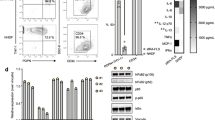Summary
Utilizing monoclonal reagents directed towards antigens of the monocyte-macrophage lineage and Ia antigens, the tissue architecture of synovial membranes obtained from patients with non-inflammatory joint diseases and patients with rheumatoid arthritis was studied. Emphasis was placed on the localization of the type I, type II and type III synoviocytes that previously had been defined by their cell surface phenotype with regard to the expression of monocyte-macrophage lineage (Mθ) and Ia antigens as well as by their phagocytic capacity or the ability to produce glycosaminoglycans. In patients with non-inflammatory joint diseases, cells with the Mθ+ Ia+ (type I) phenotype constituted the majority of synoviocytes immediately adjacent to the joint cavity; cells with this phenotype were also scattered in the subsynovial tissue and in the perivascular regions. The fibroblastoid type III cells defined by the absence of both Mθ and Ia antigens formed the major cell population in the subsynovial tissue in this patient group. In patients with rheumatoid arthritis, the Ia+ Mθ+ cells were present in a characteristic double configuration forming an intensely positive layer adjacent to the intra-articular space followed by an Ia− Mθ− layer that again was succeeded by an intensely Ia+ Mθ+ layer. Large numbers of synoviocytes bearing Mθ+ Ia+ antigens were also demonstrated in the diffusely inflamed sub-synovial tissue, in the perivascular regions as well as around and within lymphoid infiltrates. The localization of type II cells defined by the presence of Ia antigens, but the absence of Mθ antigens was indicated to be primarily in the broadened layer of synoviocytes, in the perivascular regions and within lymphoid infiltrations. While endothelial cells lacked Ia and Mθ antigens in patients with non-inflammatory joint diseases, Ia+ endothelial cells were identified in some rheumatoid samples; however, the majority of endothelial cells was also Ia negative in this patient group.
Similar content being viewed by others
References
Mohr W, Beneke G, Mohing W (1975) Proliferation of synovial lining cells and fibroblasts. Ann Rheum Dis 34: 219–224
Burmester GR, Yu DTY, Irani AM, Kunkel HG, Winchester RJ (1981) Ia+ T cells in synovial fluid and tissues of patients with rheumatoid arthritis. Arthritis Rheum 24:1370–1376
Burmester GR, Dimitriu-Bona A, Waters SJ, Winchester RJ (1983) Identification of three major synovial lining cell populations by monoclonal antibodies directed to Ia antigens and antigens associated with monocytes/macrophages and fibroblasts. Scand J Immunol 17:69–82
Norton WL, Ziff M (1966) Electron microscopic observations on the rheumatoid synovial membrane. Arthritis Rheum 9: 589
Winchester RJ, Burmester GR (1981) Demonstration of Ia antigens on certain dendritic cells and on a novel elongate cell found in human synovial tissue. Scand J Immunol 14: 439–444
Koch B, Locher P, Burmester GR, Mohr W, Kalden JR (1984) The tissue architecture of synovial membranes in inflammatory and non-inflammatory joint diseases. II. The localization of mononuclear cells as detected by monoclonal reagents directed against T lymphocyte subsets and natural killer cells. Rheumatol Int (in press)
Dimitriu-Bona A, Burmester GR, Waters SJ, Winchester RJ (1983) Human mononuclear phagocyte differentiation antigens. I. Patterns of antigenic expression on the surface of human monocytes and macrophages defined by monoclonal antibodies. J Immunol 130:145–152
Nadler LM, Stashenko P, Hardy R, Pesando JM, Yunis EJ, Schlossman SF (1981) Monoclonal antibodies defining serologically distinct HLA-D/DR related Ia-like antigens in man. Hum Immunol 1:77
Stein H, Gerdes J, Schwab U, Lemke H, Mason DY, Ziegler A, Schienle W, Diehl V (1982) Identification of hodgkin and Sternberg-Reed cells as a unique cell type derived from a newly-detected small-cell population. Int J Cancer 30: 445–459
Foon KA, Schroff RW, Gale RP (1982) Surface markers on leukemia and lymphoma cells: Recent advances. Blood 60: 1–19
Klareskog L (1982) Immune functions of human synovial cells. Phenotypic and T cell regulatory properties of macrophage-like cells that express HLA-DR. Arthritis Rheum 23: 488–501
Førre Ø, Thoen J, Lea T, Dobloug JH, Mellbye OJ, Natvig JB, Pahle J, Solheim BG (1982) In situ characterization of mononuclear cells in rheumatoid tissues, using monoclonal antibodies. No reduction of T8-positive cells or augmentation in T4-positive cells. Scand J Immunol 16:315–319
Wyllie JC, Haust MD, More RH (1966) The fine structure of synovial lining cells in rheumatoid arthritis. Lab Invest 15:519–529
Steinman RM, Chen LL, Witmer MD, Kaplan G, Nussenzweig MC, Adams JC, Cohn ZA (1980) Dendritic cells and macrophages current knowledge of their distinctive properties and functions. In: Furth R van (ed) Mononuclear phagocytes. Nijhoff, The Hague Boston London, pp 1781–1799
Burmester GR, Winchester RJ, Dimitriu-Bona A, Klein M, Steiner G, Sissons HA (1983) Delineation of four cell types comprising the giant cell tumor of bone: expression of Ia and monocyte-macrophage lineage antigens. J Clin Invest 71: 1633–1648
Klareskog L, Forsum U, Tjernlund UM, Kabelitz D, Wigren A (1981) Appearance of anti-HLA-DR-reactive cells in normal and rheumatoid synovial tissue. Scand J Immunol 14:183–192
Petrányi GG, Busch G, Milford E, Todd R, Griffin J, Reinherz E, Terhorst C, Schlossman S, Carpenter C (1982) Expression of myelo-monocytic differentiation and HLA antigens on endothelial cells. 1st International Workshop on Human Leucocyte Differentiation Antigens, Paris, November 1982
Pober JS, Gimbrone MA, Cotran RS, Reiss CS, Burakoff SJ, Fiers W, Ault KA (1983) Ia expression by vascular endothelium is inducible by activated T cells and by human γ-interferon. J Exp Med 157:1339–1352
Author information
Authors and Affiliations
Rights and permissions
About this article
Cite this article
Burmester, G.R., Locher, P., Koch, B. et al. The tissue architecture of synovial membranes in inflammatory and non-inflammatory joint diseases. Rheumatol Int 3, 173–181 (1983). https://doi.org/10.1007/BF00541597
Received:
Accepted:
Issue Date:
DOI: https://doi.org/10.1007/BF00541597




